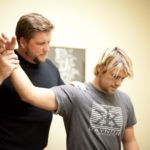The Gonstead System
Gonstead procedures are the result of extensive clinical research by Clarence S.Gonstead, founder of the world famous Gonstead Clinic of Chiropractic in Mount Horeb, Wisconsin and his associates. Doctor Gonstead’s fifty-five years of continuous practice and over four million chiropractic adjustments resulted in the most complete method of biomechanical analysis available for use by today’s doctors of chiropractic. So why don’t all chiropractors use this technique? Because the analysis takes more time and mastering the art of delivering a specific adjustment takes a LOT of practice and dedication.
The “Gonstead Chiropractor”
The Gonstead Chiropractor goes beyond what many chiropractors consider a spinal assessment by conducting a thorough analysis of your spine using five criteria to detect the presence of the vertebral subluxation complex.
Visualization – Visualization is a way to cross reference all the other findings. Your chiropractor is an expert in looking for subtle changes in your posture and movement which could indicate any problems.
 Instrumentation – The instrument of choice in the Gonstead System is the Nervoscope. The Nervoscope detects uneven distributions of heat along the spine which can be indicative of inflammation and nerve pressure. This instrument is guided down the length of your back and feels like two fingers gliding down each side of your spine.
Instrumentation – The instrument of choice in the Gonstead System is the Nervoscope. The Nervoscope detects uneven distributions of heat along the spine which can be indicative of inflammation and nerve pressure. This instrument is guided down the length of your back and feels like two fingers gliding down each side of your spine.
Static Palpation – This is simply the process of feeling (or palpating) your spine in a stationary (or static) position. Your chiropractor will feel for the presence of swelling (or edema), tenderness and any abnormal texture or tightness in the muscles and other tissues of your back.
Motion Palpation – This process involves feeling the spine while moving and bending it at various angles. This enables the chiropractor to determine how easily or difficult each segment in your spine moves in different directions.
 X-Ray Analysis – x-ray films enable your doctor to visualize the entire structure of your spine. This is helpful in evaluating posture, joint and disc integrity, vertebral misalignments and ruling out any pathologies, or recent fractures that may be present or contributing to the patient’s condition. These full-spine radiographs are taken in the standing, weight-bearing position to fully substantiate the examination findings. (GCSS 07)
X-Ray Analysis – x-ray films enable your doctor to visualize the entire structure of your spine. This is helpful in evaluating posture, joint and disc integrity, vertebral misalignments and ruling out any pathologies, or recent fractures that may be present or contributing to the patient’s condition. These full-spine radiographs are taken in the standing, weight-bearing position to fully substantiate the examination findings. (GCSS 07)
For more information on the system, Clarence Gonstead himself or to locate a Gonstead doctor in your area, visit the Gonstead Clinical Studies Society Website @ www.Gonstead.com






